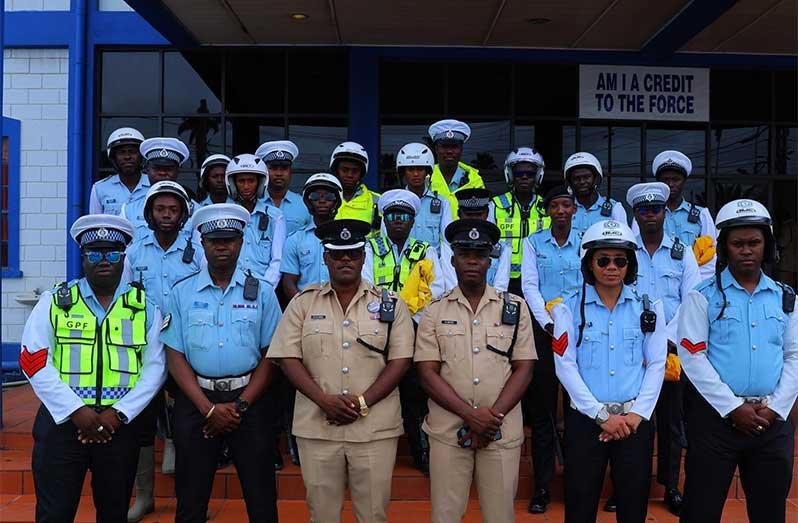Close

The Guyana Police Force (GPF) is advancing efforts to promote transparency and accountability by equipping its traffic ranks with body cameras. This initiative aims to improve the accuracy of traffic enforcement and enhance public trust through objective documentation of officer-public interactions (Stabroek News).
Recently, 38 police ranks underwent comprehensive training at the Officers’ Training Centre on the use, maintenance, and proper handling of body cameras. The training, led by the GPF’s Information Technology and Communications Department, focused on capturing reliable audio-visual evidence to support investigations and court proceedings related to criminal, civil, and traffic matters. Officers were also instructed on procedures for retrieving and securely uploading footage to ensure accountability and proper oversight (DPI Guyana).
This rollout forms part of a broader government-backed modernization of the police service. To date, over 5,000 body cameras have been acquired with plans to distribute them widely across all regional police divisions. The integration of this technology reinforces the government’s commitment to transparency, professionalism, and community-oriented policing (DPI Guyana).
The body cameras provide an important safeguard by objectively recording incidents, which helps to clarify disputes, reduce complaints, and ensure that officers adhere to proper conduct. For traffic ranks in particular, this technology enhances the integrity of enforcement actions and improves public confidence in policing processes (Stabroek News).
Moreover, the GPF views the body-camera program as a key tool for improving service delivery and accountability. By documenting real-time interactions, the force is better positioned to respond to concerns, protect both officers and citizens, and foster a culture of professionalism (DPI Guyana).
As this program expands, it is expected to strengthen relations between law enforcement and communities throughout Guyana. The adoption of body cameras aligns with global best practices where such technology has proven effective in enhancing transparency, reducing misconduct, and building trust (Stabroek News).
In summary, the Guyana Police Force’s investment in body-camera training and technology for traffic ranks reflects a progressive step forward in building a more accountable, transparent, and effective police service dedicated to the safety and rights of all Guyanese citizens.

The Guyana Project is an independent media platform delivering fact-checked, ground-level reporting on politics, economy, and public life in Guyana. With a focus on transparency and development, we bring unfiltered news and thoughtful analysis to help shape a more informed, forward-looking nation.


Lorem Ipsum is simply dummy text of the printing and typesetting industry. Lorem Ipsum has been the industry’s standard dummy text ever since the 1500s, when an unknown printer took a galley of type and scrambled it to make a type specimen book. It has survived not only five centuries, but also the leap into electronic typesetting, remaining essentially unchanged. It was popularised in the 1960s with the release of Letraset sheets containing Lorem Ipsum passages, and more recently with desktop publishing software like Aldus PageMaker including versions of Lorem Ipsum.
t is a long established fact that a reader will be distracted by the readable content of a page when looking at its layout. The point of using Lorem Ipsum is that it has a more-or-less normal distribution of letters, as opposed to using ‘Content here, content here’, making it look like readable English. Many desktop publishing packages and web page editors now use Lorem Ipsum as their default model text, and a search for ‘lorem ipsum’ will uncover many web sites still in their infancy. Various versions have evolved over the years, sometimes by accident, sometimes on purpose (injected humour and the like).
Contrary to popular belief, Lorem Ipsum is not simply random text. It has roots in a piece of classical Latin literature from 45 BC, making it over 2000 years old. Richard McClintock, a Latin professor at Hampden-Sydney College in Virginia, looked up one of the more obscure Latin words, consectetur, from a Lorem Ipsum passage, and going through the cites of the word in classical literature, discovered the undoubtable source. Lorem Ipsum comes from sections 1.10.32 and 1.10.33 of “de Finibus Bonorum et Malorum” (The Extremes of Good and Evil) by Cicero, written in 45 BC. This book is a treatise on the theory of ethics, very popular during the Renaissance. The first line of Lorem Ipsum, “Lorem ipsum dolor sit amet..”, comes from a line in section 1.10.32.